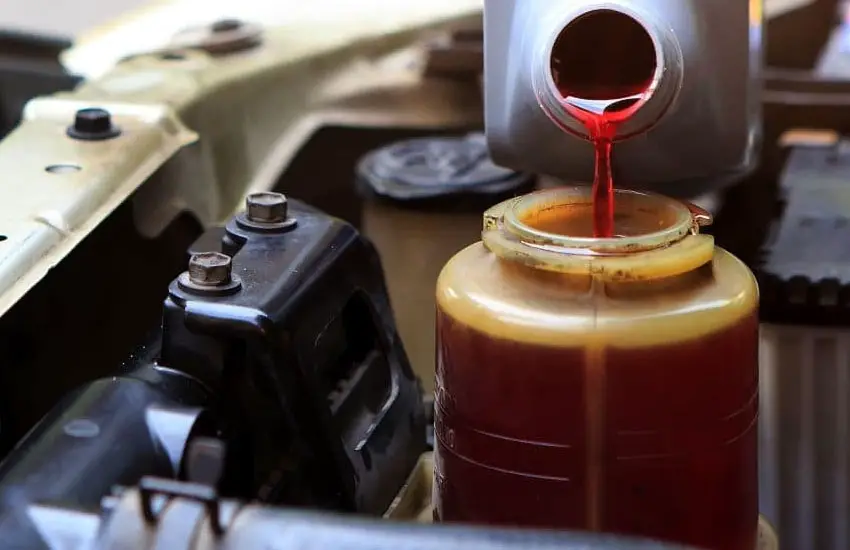As an Amazon Associate, I earn from qualifying purchases at no extra cost to you.
How to Replace Transmission Fluid: The Ultimate Guide
Changing your car's transmission fluid may sound tricky, but it's an essential part of car maintenance that can keep your vehicle running smoothly for years. Just like the oil in your engine, transmission fluid plays a crucial role in keeping everything lubricated and functioning correctly. In this guide, we will break down the steps to replace your transmission fluid and discuss why it matters so much.
Why is Transmission Fluid Important?
Transmission fluid is a special type of oil that keeps your car’s transmission system running well. The transmission helps your engine transfer power to your wheels, allowing your car to move. It is responsible for shifting gears, which makes your car accelerate or decelerate. Transmission fluid serves several vital functions:
- Lubrication: The fluid lubricates various parts of the transmission, reducing friction and wear. Just as oil lubricates your engine, transmission fluid ensures that the gears, clutches, and other components in the transmission system operate smoothly.
- Cooling: The fluid helps to cool the transmission by carrying heat away from the internal components. When the transmission operates, it generates heat. If this heat isn't managed properly, it can lead to serious damage.
- Hydraulic Pressure: Transmission fluid creates hydraulic pressure, which is necessary for the operation of automatic transmissions. This pressure enables the transmission to shift gears efficiently.
- Cleaning: Over time, transmission fluid can accumulate debris and contaminants. Fresh fluid helps to clean these impurities, ensuring that the transmission operates effectively.
How Often Should You Change Transmission Fluid?
Knowing how often to change your transmission fluid can depend on various factors, including the type of transmission, your driving habits, and the manufacturer's recommendations. Generally, most mechanics suggest changing your transmission fluid every 30,000 to 60,000 miles. However, it's always best to consult your owner's manual for specific guidance on your vehicle.
You may need to change your transmission fluid sooner if you notice any of the following signs:
- Slipping Gears: If your car seems to change gears on its own or slips out of gear while driving, it might be a sign that your transmission fluid is low or contaminated.
- Delayed Engagement: If there is a delay when shifting from park to drive or reverse, this could indicate a problem with the fluid.
- Overheating: An overheating transmission can be a sign that the fluid needs to be changed. Check the temperature gauge in your car, and if the transmission is getting too hot, it might be time for a change.
- Unusual Sounds: If you hear grinding, clunking, or whining noises when shifting gears, it may mean the fluid is low or dirty.
Tools and Materials You Will Need
Before you start replacing your transmission fluid, gather the following tools and materials:
- New Transmission Fluid: Choose the right type for your vehicle. Refer to your owner's manual for the specific fluid type. Automatic transmissions usually use a specific type of fluid called ATF (Automatic Transmission Fluid), while manual transmissions may use a different type.
- Transmission Filter (if applicable): Some vehicles have a filter that should be replaced along with the fluid.
- Funnel: A funnel will help you pour the new fluid into the transmission without spilling.
- Wrenches and Sockets: You may need these tools to remove the transmission pan or drain plug, depending on your vehicle.
- Rags or Paper Towels: These will help you clean up any spills.
- Oil Catch Pan: This will catch the old fluid when you drain it from the transmission.
- Gloves: Wearing gloves can protect your hands from dirty fluid and chemicals.
- Safety Glasses: Safety glasses will protect your eyes while you work under the vehicle.
- Jack and Jack Stands: If your car is low to the ground, you may need a jack to lift it safely.

Steps to Replace Transmission Fluid
Now that you have your tools and materials ready, let's go through the steps to replace your transmission fluid.
Step 1: Prepare Your Vehicle
Before you begin, ensure that your vehicle is parked on a flat surface, and the engine is cool. Engage the parking brake for added safety. If your car is low to the ground, use a jack to lift it and secure it with jack stands. Always follow safety guidelines when working under a vehicle.
Step 2: Locate the Transmission Drain Plug or Pan
Next, you need to find the transmission drain plug or pan. The drain plug is usually located at the bottom of the transmission. If your vehicle does not have a drain plug, you will need to remove the transmission pan. This pan can be found on the underside of the vehicle and is typically held in place with bolts.
Step 3: Drain the Old Fluid
If your car has a drain plug, use a wrench to loosen it. Be careful; the fluid may be warm or hot. Place your oil catch pan underneath the drain plug to catch the old fluid as it drains out. If you are removing the transmission pan, loosen the bolts slowly and carefully. The old fluid will flow out once you remove the pan.
Let the fluid drain completely. This process can take a few minutes. If there is a filter, check if it needs replacing as well. Some filters can be cleaned and reused, while others must be replaced.
Step 4: Clean the Transmission Pan
Once the old fluid is drained, clean the transmission pan with a rag or paper towels. Removing any dirt or debris is essential to ensure that nothing contaminates the new fluid. If your vehicle has a filter, replace it according to the manufacturer’s instructions. Make sure the new filter is properly seated to prevent leaks.
Step 5: Reattach the Pan or Replace the Drain Plug
If you removed the transmission pan, replace the gasket or seal to prevent leaks. Then, reattach the pan securely, making sure all bolts are tightened evenly. If you are using a drain plug, replace it and tighten it securely.
Step 6: Add New Transmission Fluid
Now it's time to add the new transmission fluid. Locate the transmission dipstick tube, usually marked with a colored handle. Insert the funnel into this tube and pour in the new fluid slowly. Refer to your owner's manual for the correct amount of fluid to add. Be careful not to overfill, as too much fluid can cause leaks and transmission issues.
Step 7: Check the Fluid Level
After adding the new fluid, start the engine and let it run for a few minutes. With the engine running, shift the transmission through all the gears, pausing for a few seconds in each one. This action allows the new fluid to circulate throughout the system. After this, put the vehicle back in park and check the fluid level using the dipstick. Add more fluid if necessary.
Step 8: Test Drive Your Vehicle
Once the fluid level is correct, take your car for a short test drive. Pay attention to how the transmission shifts. If everything feels smooth and there are no unusual sounds, you've successfully replaced the transmission fluid. After your test drive, check for any leaks under the vehicle.
Maintenance Tips for Your Transmission
To keep your transmission running well, consider the following maintenance tips:
- Regular Fluid Checks: Make it a habit to check your transmission fluid regularly. Look for any signs of leaks or discoloration. Fresh transmission fluid should be a bright red color and have a sweet smell. Dark or burnt fluid may indicate that it's time for a change.
- Avoid Overheating: Try to avoid situations that can overheat your transmission. This includes towing heavy loads or driving in stop-and-go traffic for long periods.
- Follow Manufacturer's Recommendations: Always follow the guidelines set forth by your vehicle's manufacturer regarding transmission maintenance. This includes fluid changes and any other maintenance tasks.
- Use the Right Fluid: Ensure you are using the correct type of transmission fluid for your vehicle. Using the wrong fluid can lead to problems and even damage.
- Pay Attention to Warning Signs: Be aware of any warning signs, such as slipping gears, unusual noises, or delayed engagement. Addressing these issues early can prevent more severe damage.
I hope this guide has given you the confidence to replace your transmission fluid. It is a straightforward process that can significantly enhance the performance and longevity of your vehicle. Regular maintenance of your transmission is essential for a smooth and safe driving experience.
Are These Questions in Your Mind?
Is it safe to change transmission fluid yourself?
Yes, it is safe to change your transmission fluid yourself as long as you follow proper safety procedures and guidelines. Make sure you have the right tools and take your time to avoid mistakes.
Can I use any type of transmission fluid?
No, you should use the specific type of transmission fluid recommended in your vehicle’s owner manual. Using the wrong fluid can damage your transmission.
Do I need to change the transmission filter every time I change the fluid?
It depends on your vehicle. Some vehicles require a filter change every time you replace the fluid, while others do not. Check your owner's manual for specific recommendations.
Is it normal for transmission fluid to smell burnt?
No, burnt-smelling transmission fluid is not normal. It can indicate overheating or contamination and should be addressed immediately.
Can I mix different brands of transmission fluid?
It is not recommended to mix different brands of transmission fluid, as they may have different additives that can affect performance. Stick to one brand and type.
Is it okay to drive with low transmission fluid?
Driving with low transmission fluid is not safe. It can lead to serious damage to your transmission and affect your ability to shift gears.
Do I need to let the engine run while adding new transmission fluid?
Yes, running the engine while adding new transmission fluid allows the fluid to circulate properly throughout the system.
Can I tell if I need a transmission fluid change by looking at the color?
Yes, the color of the fluid can give you clues. Fresh transmission fluid is usually bright red, while dark brown or black fluid may indicate that it needs to be changed.
Is it necessary to take my car to a mechanic for transmission fluid changes?
While you can change the fluid yourself, taking your car to a mechanic is advisable if you are unsure about the process or do not have the right tools.
Do I need to change the transmission fluid more often if I drive in harsh conditions?
Yes, if you frequently drive in harsh conditions, such as heavy traffic, towing, or extreme temperatures, you may need to change your transmission fluid more often.











